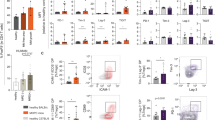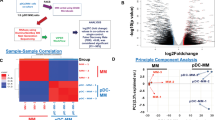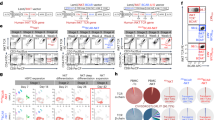Abstract
Multiple myeloma (MM) is a plasma cell malignancy where MM cell growth is supported by the bone marrow (BM) microenvironment with poorly defined cellular and molecular mechanisms. MM cells express CD40, a receptor known to activate autocrine secretion of cytokines and elicit proliferation. Activated T helper (Th) cells express CD40 ligand (CD40L) and BM Th cells are significantly increased in MM patients. We hypothesized that activated BM Th cells could support MM cell growth. We here found that activated autologous BM Th cells supported MM cell growth in a contact- and CD40L-dependent manner in vitro. MM cells had retained the ability to activate Th cells that reciprocated and stimulated MM cell proliferation. Autologous BM Th cells supported MM cell growth in xenografted mice and were found in close contact with MM cells. MM cells secreted chemokines that attracted Th cells, secretion was augmented by CD40-stimulation. Within 14 days of culture of whole BM aspirates in autologous serum, MM cells and Th cells mutually stimulated each other, and MM cells required Th cells for further expansion in vitro and in mice. The results suggest that Th cells may support the expansion of MM cells in patients.
This is a preview of subscription content, access via your institution
Access options
Subscribe to this journal
Receive 12 print issues and online access
$259.00 per year
only $21.58 per issue
Buy this article
- Purchase on Springer Link
- Instant access to full article PDF
Prices may be subject to local taxes which are calculated during checkout






Similar content being viewed by others
References
Perez-Andres M, Almeida J, Martin-Ayuso M, Moro MJ, Martin-Nunez G, Galende J et al. Characterization of bone marrow T cells in monoclonal gammopathy of undetermined significance, multiple myeloma, and plasma cell leukemia demonstrates increased infiltration by cytotoxic/Th1 T cells demonstrating a squed TCR-Vbeta repertoire. Cancer 2006; 106: 1296–1305.
Bianchi G, Munshi NC . Pathogenesis beyond the cancer clone(s) in multiple myeloma. Blood 2015; 125: 3049–3058.
Dunn GP, Old LJ, Schreiber RD . The immunobiology of cancer immunosurveillance and immunoediting. Immunity 2004; 21: 137–148.
Zitvogel L, Tesniere A, Kroemer G . Cancer despite immunosurveillance: immunoselection and immunosubversion. Nat Rev Immunol 2006; 6: 715–727.
Haabeth OA, Lorvik KB, Hammarstrom C, Donaldson IM, Haraldsen G, Bogen B et al. Inflammation driven by tumour-specific Th1 cells protects against B-cell cancer. Nat Commun 2011; 2: 240.
Haabeth OA, Tveita AA, Fauskanger M, Schjesvold F, Lorvik KB, Hofgaard PO et al. How do CD4(+) T cells detect and eliminate tumor cells that either lack or express MHC class II molecules? Front Immunol 2014 2014; 5: 174.
Tveita AA, Schjesvold F, Haabeth OA, Fauskanger M, Bogen B . Tumors escape CD4+ T-cell-mediated immunosurveillance by impairing the ability of infiltrating macrophages to indirectly present tumor antigens. Cancer Res 2015; 75: 3268–3278.
Leone P, Berardi S, Frassanito MA, Ria R, De ReV, Cicco S et al. Dendritic cells accumulate in the bone marrow of myeloma patients where they protect tumor plasma cells from CD8+ T cell killing. Blood 2015; 126: 1443–1451.
Flavell RA, Sanjabi S, Wrzesinski SH, Licona-Limon P . The polarization of immune cells in the tumour environment by TGFbeta. Nat Rev Immunol 2010; 10: 554–567.
Ruffell B, DeNardo DG, Affara NI, Coussens LM . Lymphocytes in cancer development: polarization towards pro-tumor immunity. Cytokine Growth Factor Rev 2010; 21: 3–10.
Zangani MM, Froyland M, Qiu GY, Meza-Zepeda LA, Kutok JL, Thompson KM et al. Lymphomas can develop from B cells chronically helped by idiotype-specific T cells. J Exp Med 2007; 204: 1181–1191.
Os A, Burgler S, Ribes AP, Funderud A, Wang D, Thompson KM et al. Chronic lymphocytic leukemia cells are activated and proliferate in response to specific T helper cells. Cell Rep 2013; 4: 566–577.
Kuppers R . Mechanisms of B-cell lymphoma pathogenesis. Nat Rev Cancer 2005; 5: 251–262.
Wein F, Kuppers R . The role of T cells in the microenvironment of Hodgkin lymphoma. J Leukoc Biol 2016; 99: 45–50.
Ostad M, Andersson M, Gruber A, Sundblad A . Expansion of immunoglobulin autoreactive T-helper cells in multiple myeloma. Blood 2008; 111: 2725–2732.
Prabhala RH, Pelluru D, Fulciniti M, Prabhala HK, Nanjappa P, Song W et al. Elevated IL-17 produced by TH17 cells promotes myeloma cell growth and inhibits immune function in multiple myeloma. Blood 2010; 115: 5385–5392.
Tokoyoda K, Hauser AE, Nakayama T, Radbruch A . Organization of immunological memory by bone marrow stroma. Nat Rev Immunol 2010; 10: 193–200.
Herndler-Brandstetter D, Landgraf K, Jenewein B, Tzankov A, Brunauer R, Brunner S et al. Human bone marrow hosts polyfunctional memory CD4+ and CD8+ T cells with close contact to IL-15-producing cells. J Immunol 2011; 186: 6965–6971.
Meers S, Kasran A, Boon L, Lemmens J, Ravoet C, Boogaerts M et al. Monocytes are activated in patients with myelodysplastic syndromes and can contribute to bone marrow failure through CD40-CD40L interactions with T helper cells. Leukemia 2007; 21: 2411–2419.
Lesley R, Kelly LM, Xu Y, Cyster JG . Naive CD4 T cells constitutively express CD40L and augment autoreactive B cell survival. Proc Natl Acad Sci USA 2006; 103: 10717–10722.
Ford GS, Barnhart B, Shone S, Covey LR . Regulation of CD154 (CD40 ligand) mRNA stability during T cell activation. J Immunol 1999; 162: 4037–4044.
Monteiro JP, Benjamin A, Costa ES, Barcinski MA, Bonomo A . Normal hematopoiesis is maintained by activated bone marrow CD4+ T cells. Blood 2005; 105: 1484–1491.
Tai YT, Li X, Tong X, Santos D, Otsuki T, Catley L et al. Human anti-CD40 antagonist antibody triggers significant antitumor activity against human multiple myeloma. Cancer Res 2005; 65: 5898–5906.
Tai YT, Podar K, Mitsiades N, Lin B, Mitsiades C, Gupta D et al. CD40 induces human multiple myeloma cell migration via phosphatidylinositol 3-kinase/AKT/NF-kappa B signaling. Blood 2003; 101: 2762–2769.
Urashima M, Chauhan D, Uchiyama H, Freeman GJ, Anderson KC . CD40 ligand triggered interleukin-6 secretion in multiple myeloma. Blood 1995; 85: 1903–1912.
Yi Q, Dabadghao S, Osterborg A, Bergenbrant S, Holm G . Myeloma bone marrow plasma cells: evidence for their capacity as antigen-presenting cells. Blood 1997; 90: 1960–1967.
Walz S, Stickel JS, Kowalewski DJ, Schuster H, Weisel K, Backert L et al. The antigenic landscape of multiple myeloma: mass spectrometry (re)defines targets for T-cell-based immunotherapy. Blood 2015; 126: 1203–1213.
Harada H, Kawano MM, Huang N, Harada Y, Iwato K, Tanabe O et al. Phenotypic difference of normal plasma cells from mature myeloma cells. Blood 1993; 81: 2658–2663.
Garrone P, Neidhardt EM, Garcia E, Galibert L, van KC, Banchereau J . Fas ligation induces apoptosis of CD40-activated human B lymphocytes. J Exp Med 1995; 182: 1265–1273.
Duhen T, Campbell DJ . IL-1beta promotes the differentiation of polyfunctional human CCR6+CXCR3+ Th1/17 cells that are specific for pathogenic and commensal microbes. J Immunol 2014; 193: 120–129.
Becattini S, Latorre D, Mele F, Foglierini M, De Gregorio C, Cassotta A et al. T cell immunity. Functional heterogeneity of human memory CD4(+) T cell clones primed by pathogens or vaccines. Science 2015; 347: 400–406.
Buckle CH, De Leenheer E, Lawson MA, Yong K, Rabin N, Perry M et al. Soluble rank ligand produced by myeloma cells causes generalised bone loss in multiple myeloma. PLoS ONE 2012; 7: e41127.
Schmiedel BJ, Scheible CA, Nuebling T, Kopp HG, Wirths S, Azuma M et al. RANKL expression, function, and therapeutic targeting in multiple myeloma and chronic lymphocytic leukemia. Cancer Res 2013; 73: 683–694.
Herndler-Brandstetter D, Landgraf K, Tzankov A, Jenewein B, Brunauer R, Laschober GT et al. The impact of aging on memory T cell phenotype and function in the human bone marrow. J Leukoc Biol 2012; 91: 197–205.
Moss P, Gillespie G, Frodsham P, Bell J, Reyburn H . Clonal populations of CD4+ and CD8+ T cells in patients with multiple myeloma and paraproteinemia. Blood 1996; 87: 3297–3306.
Kim D, Park CY, Medeiros BC, Weissman IL . CD19-CD45 low/- CD38 high/CD138+ plasma cells enrich for human tumorigenic myeloma cells. Leukemia 2012; 26: 2530–2537.
Tokoyoda K, Zehentmeier S, Hegazy AN, Albrecht I, Grun JR, Lohning M et al. Professional memory CD4+ T lymphocytes preferentially reside and rest in the bone marrow. Immunity 2009; 30: 721–730.
Zingone A, Wang W, Corrigan-Cummins M, Wu SP, Plyler R, Korde N et al. Altered cytokine and chemokine profiles in multiple myeloma and its precursor disease. Cytokine 2014; 69: 294–297.
Ehrlich LA, Roodman GD . The role of immune cells and inflammatory cytokines in Paget's disease and multiple myeloma. Immunol Rev 2005; 208: 252–266.
Andrews SW, Kabrah S, May JE, Donaldson C, Morse HR . Multiple myeloma: the bone marrow microenvironment and its relation to treatment. Br J Biomed Sci 2013; 70: 110–120.
Sallusto F, Lanzavecchia A . Heterogeneity of CD4+ memory T cells: functional modules for tailored immunity. Eur J Immunol 2009; 39: 2076–2082.
Trentin L, Miorin M, Facco M, Baesso I, Carraro S, Cabrelle A et al. Multiple myeloma plasma cells show different chemokine receptor profiles at sites of disease activity. Br J Haematol 2007; 138: 594–602.
Moller C, Stromberg T, Juremalm M, Nilsson K, Nilsson G . Expression and function of chemokine receptors in human multiple myeloma. Leukemia 2003; 17: 203–210.
Bishop GA, Moore CR, Xie P, Stunz LL, Kraus ZJ . TRAF proteins in CD40 signaling. Adv Exp Med Biol 2007; 597: 131–151.
Teoh G, Tai YT, Urashima M, Shirahama S, Matsuzaki M, Chauhan D et al. CD40 activation mediates p53-dependent cell cycle regulation in human multiple myeloma cell lines. Blood 2000; 95: 1039–1046.
Acknowledgements
This work was supported by grants from the Norwegian South-East Health region to LAM, the Research Council of Norway through its Centres of Excellence funding scheme (Project Number 179573/V40) to LAM, the Torsteds fund, the Raagholt fund and Unifor to DW.
Author contributions
DW, YF, CM, POH, SB, AP-R, AT and LAM performed experiments. JD, YF, FS and GET provided patient samples and clinical information. DW, YF, CM, SB, AP-R, POH, BB, AT and LAM analyzed data. All co-authors contributed to data interpretation, manuscript preparation. DW and LAM designed the research and wrote the paper.
Author information
Authors and Affiliations
Corresponding authors
Ethics declarations
Competing interests
The authors declare no conflict of interest.
Additional information
Supplementary Information accompanies this paper on the Leukemia website
Supplementary information
Rights and permissions
About this article
Cite this article
Wang, D., Fløisand, Y., Myklebust, C. et al. Autologous bone marrow Th cells can support multiple myeloma cell proliferation in vitro and in xenografted mice. Leukemia 31, 2114–2121 (2017). https://doi.org/10.1038/leu.2017.69
Received:
Revised:
Accepted:
Published:
Issue Date:
DOI: https://doi.org/10.1038/leu.2017.69



